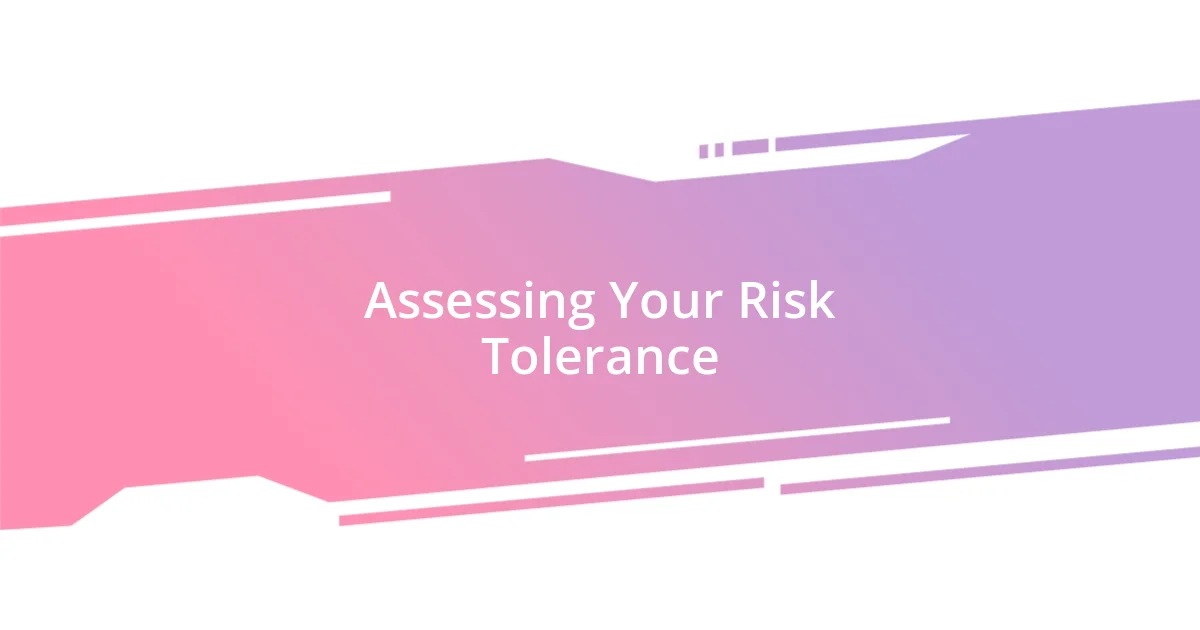Key takeaways:
- Diversification is essential in crypto investing, balancing well-established assets like Bitcoin and Ethereum with smaller, high-potential projects to manage risk and improve engagement.
- Understanding personal risk tolerance helps in building a suitable portfolio; different strategies can be employed based on whether one seeks stable, medium-risk, or high-risk investments.
- Regular rebalancing and using various tools for tracking performance are vital to maintain alignment with financial goals and manage emotions surrounding investments.

Understanding Crypto Portfolio Diversification
Diversifying a crypto portfolio means spreading your investments across various cryptocurrencies rather than putting all your funds into one. I remember feeling that initial rush, investing heavily in the latest coin, only to watch its value plummet. It was then that I realized the importance of supporting my main assets with a variety of altcoins, stablecoins, and even DeFi tokens.
When I began diversifying, I aimed for a mix that balanced risk and potential return. I often hear people ask, “How much should I allocate to each asset?” From my experience, it’s not just about percentages but understanding the characteristics of each asset. For example, while Bitcoin and Ethereum offer established credibility, smaller projects can provide significant growth if researched carefully.
It’s crucial to align your diversification strategy with your risk tolerance and investment goals. I often reflect on my early mistakes—I was overly focused on quick gains instead of thinking long-term. Now, with a diversified approach, I not only feel more secure but also more engaged in the crypto space. What about you? Have you considered how different assets can complement each other in your portfolio?

Types of Cryptocurrencies to Consider
When venturing into the world of cryptocurrencies, it’s important to understand the different types available to make informed decisions. Personally, I’ve found that each category serves a unique purpose in a diversified portfolio. From my journey, I learned that while some assets promise stability, others can offer exhilarating growth potential or innovative utility.
Here are some types of cryptocurrencies to consider:
- Bitcoin (BTC): The original cryptocurrency and a store of value, often seen as “digital gold.”
- Ethereum (ETH): Known for its smart contract capabilities, it’s essential for anyone interested in decentralized applications.
- Stablecoins (e.g., USDT, USDC): These are pegged to fiat currencies, providing a safe haven during market volatility.
- DeFi tokens (e.g., Uniswap, Aave): These empower users to lend and borrow without intermediaries, sparking my interest in decentralized finance.
- NFT-related tokens (e.g., Flow, Tezos): As someone enamored by digital art, I’ve been exploring platforms supporting non-fungible tokens for their unique market potential.
- Meme coins (e.g., Dogecoin, Shiba Inu): Though risky, these can surprisingly yield unexpected returns and serve as a fun addition to my collection.
My past experiences taught me the significance of researching each category’s underlying technology and use case. It’s a balancing act, and in each investment, I find a piece of the larger puzzle of my portfolio.

Assessing Your Risk Tolerance
Assessing your risk tolerance is a fundamental step in diversifying your crypto portfolio. I recall a time when I was tempted to invest heavily in a highly praised altcoin, only to realize afterward that my risk appetite didn’t match the volatility of that asset. Understanding your willingness to endure market fluctuations can save you from making impulsive decisions that could derail your financial goals.
I often encourage fellow investors to reflect on their personal circumstances and long-term objectives. For example, consider how much you’re willing to lose without losing sleep at night. For me, adopting a more cautious approach allowed me to explore emerging projects without risking my primary investments. It’s a balancing act between ambition and prudence, making sure your risk profile aligns with your portfolio strategy.
When assessing risk tolerance, I believe a self-assessment can help clarify your limits. Are you seeking rapid gains or steady growth? Personally, I’ve found that combining a few high-risk, high-reward assets with stable investments has been a winning strategy for me. That way, even during market downturns, my core holdings provide a safety net, allowing me to sleep a little easier at night.
| Risk Tolerance Level | Investment Approach |
|---|---|
| Low | Focus on stablecoins and established assets like Bitcoin and Ethereum. |
| Medium | Mix of stable assets with selected altcoins; maintain a balanced approach. |
| High | Willingness to invest in speculative projects and ICOs, seeking high returns. |

Strategies for Allocating Investments
When I allocate my investments, I find it crucial to establish clear percentages for each asset class. For example, I typically allocate around 50% to established cryptocurrencies like Bitcoin and Ethereum, as they provide a safety net for my portfolio. This blend of stability gives me confidence to explore riskier assets without feeling overwhelmed.
In addition to setting percentages, I regularly reassess my allocations based on market trends and personal experiences. I remember a time when I did not allocate enough to stablecoins during a market downturn. The anxiety I felt during that period was palpable, reminding me of the importance of maintaining a cash reserve. Asking myself whether I’m comfortable with my current strategy keeps me adaptable and more prepared for sudden shifts.
Finally, I believe that diversification should also include geographical and technological factors. Some of my investments are in projects based in emerging markets, which often unlock unique opportunities. Have I missed out on potential growth by not exploring these avenues sooner? Reflecting on that question, I continuously seek to broaden my horizons and ensure my portfolio isn’t just a one-dimensional view of the crypto space.

Rebalancing Your Portfolio Over Time
Rebalancing my portfolio has become a ritual I genuinely look forward to. Every few months, I sit down with my investments and assess their performance. There have been times when I’ve found that an asset unexpectedly surged in value, shifting my initial allocations considerably. I remember one instance where my altcoin holdings shot up, making my Bitcoin allocation feel disproportionately small. It taught me the importance of maintaining my intended distribution to stay aligned with my financial goals.
As I reflect on my rebalancing process, I often ask myself how these changes impact my risk tolerance. After one particularly volatile market period, I realized my portfolio had become more aggressive than I was comfortable with. It was a wake-up call; I had to sell off some of my higher-risk assets to regain the peace of mind that I value so much. I find that balancing fear and greed helps steer me back to a grounded investment approach.
Moreover, I believe rebalancing is not just about numbers; it’s an emotional journey. Often, I find myself grappling with attachment to certain investments. I recall a time when I was hesitant to let go of a project I was emotionally invested in, even when it no longer fit my strategy. That moment was humbling, showing me how crucial it is to view my portfolio through a logical lens. Realizing that sentiment can cloud judgment pushed me to embrace a more disciplined, objective approach to rebalancing. How about you? What emotions come into play when you think about your investment decisions?

Tools for Tracking Portfolio Performance
When it comes to tracking portfolio performance, I rely heavily on a combination of analytical tools and personal insight. There are several platforms, like CoinGecko and Blockfolio, that provide real-time updates on prices and market trends. I remember when I first started using these tools; they transformed the way I approached my investments by showing me not just the numbers, but also the bigger picture of market movements. Do you find real-time updates essential in your trading journey, too?
Another tool I’ve found invaluable is a good spreadsheet. While some may consider this old-fashioned, there’s something profoundly satisfying about customizing my own portfolio tracker. Using Google Sheets, I can set up formulas to calculate my gains and losses with a few clicks. The sense of control I get from this hands-on approach is unmatched. I often reflect on how numbers tell stories; I’ve caught myself smiling at a red cell when I remember the lesson learned from a previous mistake. Have you ever experienced a sense of kinship with the numbers in your portfolio?
Lastly, I appreciate the community aspect provided by discussion forums and social media, where I can compare notes with other investors. Platforms like Twitter or specialized subreddits allow me to gain perspectives that I might overlook on my own. I recall a lively discussion about market sentiment that helped me reassess a risky investment before it led to potential regret. Engaging with a community can open doors to insights I never would have considered alone. How has connecting with others influenced your investment strategies?














